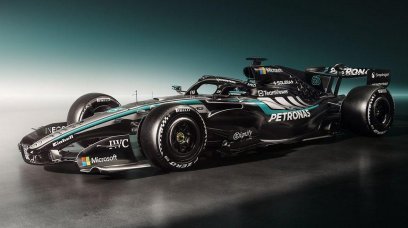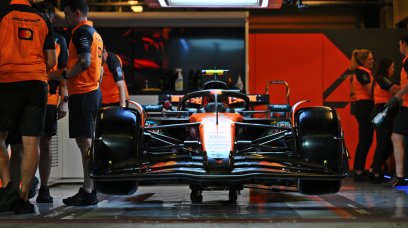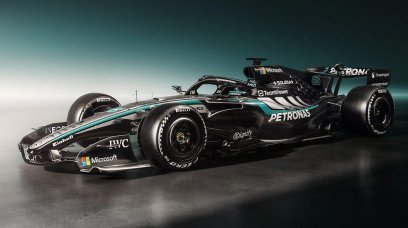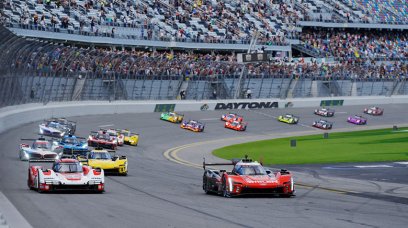Formula 1's sprint format is the latest system to set the grid for Sunday's Grand Prix. For the first time ever, a race will dictate where the drivers start for the British GP in Silverstone. This new format will be used at the Italian GP and either the US or Brazilian GP with points on offer for the top three finishers. RacingNews365.com takes a look at how the fight for pole position has changed over the years.
Two-day format 1950-1995
For a remarkable 46 years, F1 retained the same qualifying system of having one session on Friday and another on Saturday. Your fastest time from the two days would decide where you started on the grid. A pretty simple formula but it did not always end with a climax.
One hour shootout 1996-2002
From 1996, qualifying happened solely on a Saturday afternoon. Each driver had 12 laps to set their fastest time which decided the order of the grid. Another fairly straightforward format.
One-lap qualifying 2003-2004
In championship order, drivers would go out one by one on Friday which determined the running order for Saturday. On Saturday, the drivers each went out in reverse order of the previous day's result go put it all on the line for one lap. To add a strategical element, you had to qualify on your race fuel load. F1 introduced a single-lap format to decide the grid. One-by-one, Friday running would determine the order for a Saturday, and one flying lap the following day would sort the order for the race From 2004, both sessions took place on a Saturday. The major disadvantage with this format was the ever-changing track conditions which guaranteed to help or hinder some drivers.
Aggregate qualifying 2005 (six rounds)
In 2005, Bernie Ecclestone decided to tweak qualifying by using an aggregated format. The lap times from two single qualifying runs were added together to form the grid. On Saturday afternoon, every driver would do a lap on low fuel before another lap on Sunday but on their race starting fuel. It did not go down well with fans as well as the media who said they could not publish the qualifying order in the morning newspapers. After six races, the format was dropped and F1 returned to single lap qualifying just on a Saturday.
Knockout qualifying 2006-2009
The 2006 F1 season saw the beginning of a much-loved qualifying format. Qualifying was split into three parts with the slowest drivers eliminated after each segment, the number varying from season to season depending on the number of drivers on the grid. After each segment, the times did not carry over which remains case today. It was instantly loved due to the jeopardy of a top driver being eliminated in Q1 or Q2. The one problem was in Q3 when drivers still had to qualify on their starting fuel loads when fans wanted to see the cars on low fuel.
The current format 2010 to 2015
Gone were the days of refuelling which enabled the drivers to be on maximum attack during the climax of qualifying. Originally you did have to qualify on the tyres you used in Q3 for the start of the race (this was changed to Q2 which is the case today) and the length of each segment of qualifying have undergone slight changes too.
Elimination qualifying 2016 (two rounds)
In 2016, the FIA decided to make a change to qualifying by eliminating the slowest car after seven minutes in Q1. This process of knocking out the driver that is at the bottom of the leaderboard carried on throughout the session, with the slowest driver eliminated every 90 seconds until the qualifying segment ended. In Q2 and Q3, the same format applied - whoever was slowest was eliminated until one car remained. It was a confusing concept and loathed by the fans. The format lasted for just two races at the 2016 Australian and Bahrain Grand Prix before the FIA reverted back to the current system.
Back to the working format 2016-?
And so F1 returned to the 2010-2016 format which is still used today. With 20 drivers on the grid, the five slowest drivers are eliminated in Q1, followed by another five in Q2 leaving the top 10 to battle it out for pole position in Q3. But, things never stay the same for too long in modern F1.
Sprint race 2021-?
This weekend's British GP will see the latest qualifying format take its turn to see if it can be loved by the fans. For the first time ever, a race will decide the grid for Sunday. There will be no mandatory pit stops, a free choice of starting tyre for the sprint and main races, a simple 100km dash to the flag to see who gets pole position. Three championship points are on offer for the winner of the sprint race (pole sitter), with two points for second and one point for third place. These points could be crucial for Red Bull and Mercedes who are battling it out in the Constructors' Championship. The normal knockout qualifying will remain but will take place on Friday evening to set the grid for the sprint race. Then, the result of the sprint will decide the order for Sunday's main race. We will wait to see how this very different format goes down with the fans.
Most read







